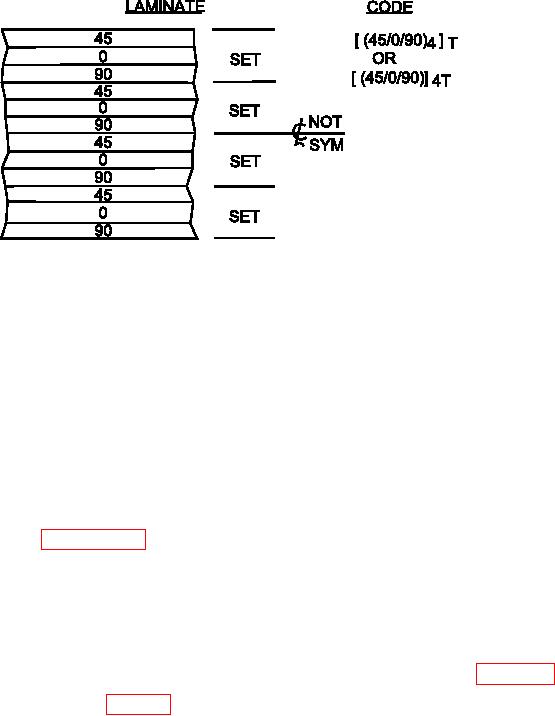
TM 1-1500-204-23-11
Figure 5-23. Example Sets for Non-Symmetric Laminates
5-9. FABRIC/HYBRID
LAMINATE/ORIENTATION
specifying that plies are to be laid up either "warp-face
CODE. In general, fabric plies are followed by a
up" or "warp-face down" on either side of the mid-plane
capital letter "F". For example, "0F" indicates a ply of
of the laminate, we can achieve perfect symmetry
fabric with its warp yarns traveling in the 0 direction.
and avoid thermal distortion. One popular way of
If there is no capital letter after the ply it is assumed
depicting this in drawings and shorthand code is to
to be unidirectional tape. If the entire layup contains
place an arrow after harness satin weave fabric plies
one type of ply, the capital "F" may follow the closing
indicating that the ply is to be installed warp-face up
bracket. This calls for caution when using the sign
(↑) or warp-face down (↓).
since a "45" indicates two unidirectional tape plies,
the irst at +45 and the second at -45, whereas
b. Hybrid Laminates. If more than one type of
"45F" indicates a fabric ply in which the warp yarns
material is used in a laminate, the material will need
may travel at either + OR 45. Additional consid-
to be designated for each material by the use of
erations need to be made if the fabrics used are
augmented subscripts. For example, "G" or "FG"
harness satin weaves (see paragraph 4-3) Harness
may represent a iberglass ply, "K" an aramid ply,
satins are, by nature, asymmetrical fabrics and are
and "C" a carbon iber ply. The augmented subscripts
therefore more prone to warping and twisting caused
will need to be deined in the document.
by thermal stresses during the cure cycle.
5-10. BRAIDING ORIENTATION CODE. The braid-
a. Carbon Laminates. This is especially true in
ing orientation code is used to describe the iber
carbon laminates cured at 350 F or higher. The key
geometry of a two-dimensional braided preform. For
to maintaining symmetry with harness satin fabrics
information beyond what is provided refer to ASTM
lies in identifying the warp-face of the material. The
D 6507 11. The information in igure 5-24 is an
warp-face is the side of the fabric on which we
excerpt from CMH-17F.
see predominantly warp yarns. (See igure 4-8.) By

